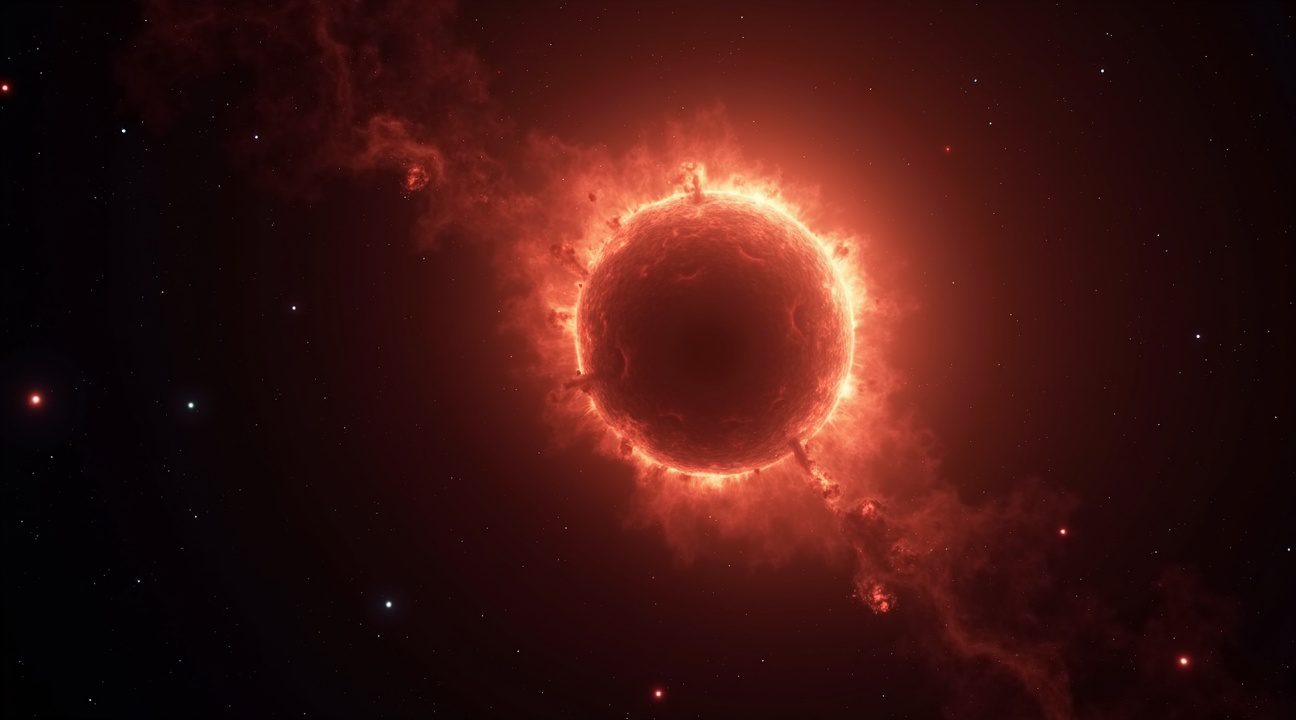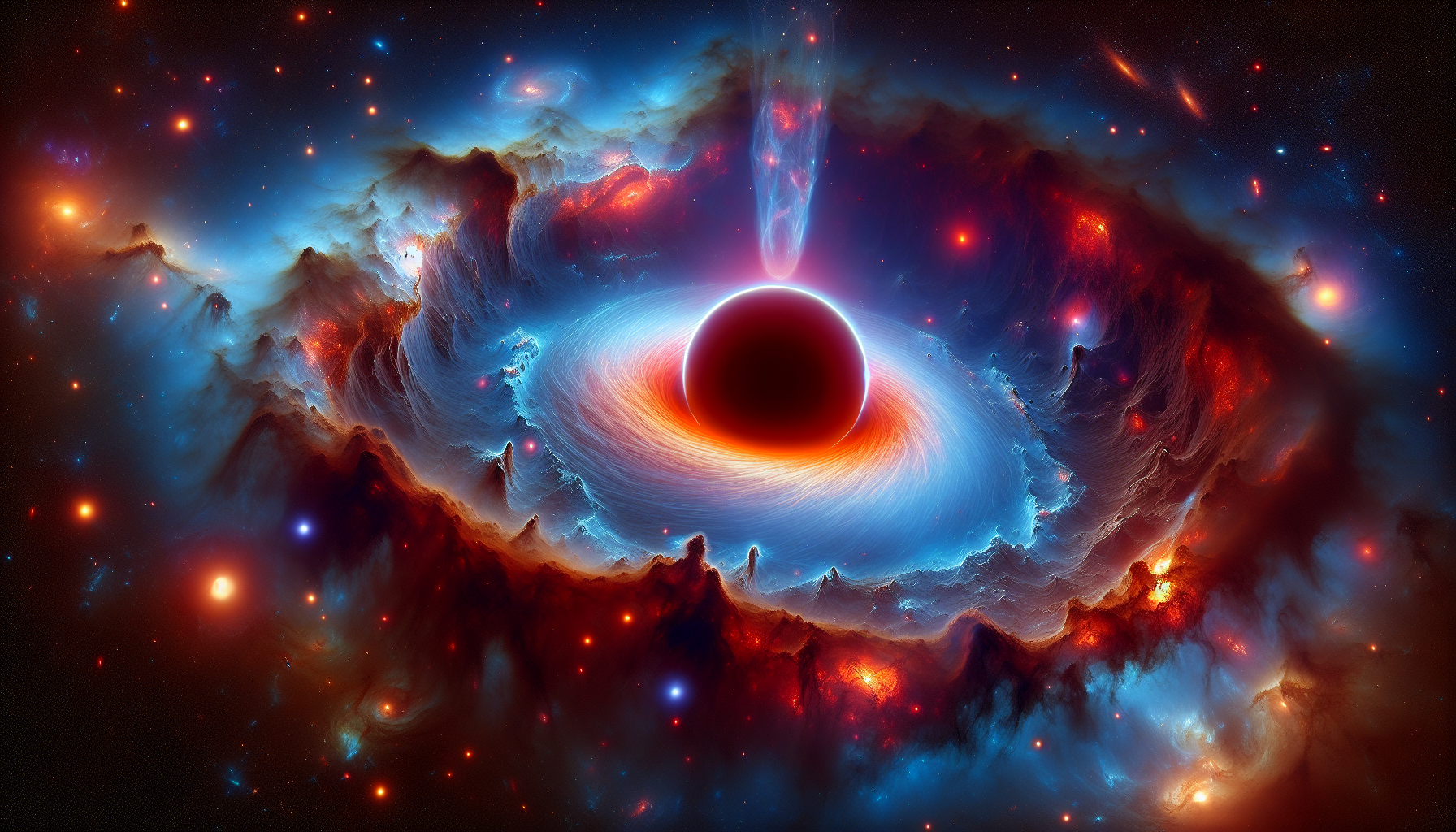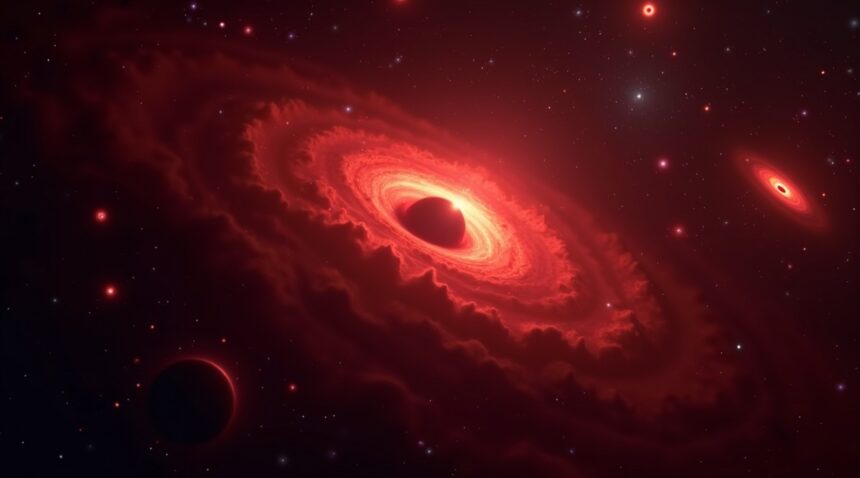The James Webb Space Telescope (JWST) has unveiled a groundbreaking discovery: a new class of cosmic entities known as “black hole stars,” offering unprecedented insights into the early universe.
Key Takeaways
- Black hole stars are fueled by rapidly accreting black holes enveloped in dense gas shells, which glow like stars but differ in that they don’t rely on nuclear fusion.
- They manifest as “little red dots” in JWST observations, primarily emitting radiation in the mid-infrared range, making them undetectable by earlier telescopes such as Hubble.
- Some of these objects represent light that began its journey roughly 12 billion years ago, offering a glimpse into events less than 2 billion years after the Big Bang—during the period known as cosmic dawn.
- This discovery provides crucial clues to how supermassive black holes managed to form rapidly in the early universe, potentially resolving the mystery of billion-solar-mass black holes at such young cosmic ages.
- JWST’s sophisticated infrared imaging was key to spotting these elusive phenomena, showcasing its power to explore parts of the cosmos previously hidden from view and expand our understanding of the universe’s formative years.
This breakthrough not only enhances our understanding of cosmic evolution but also underscores the capabilities of the James Webb Space Telescope in transforming modern astronomy. As investigations continue, scientists anticipate even more revelations that may redefine what we know about the origins of galaxies and black holes.
JWST Identifies Mysterious “Black Hole Stars” in the Early Universe
The James Webb Space Telescope has made a remarkable discovery that’s reshaping our understanding of the early universe. I’ve been following these findings closely, and what JWST has uncovered is nothing short of extraordinary—a new class of cosmic objects called “black hole stars.”
These enigmatic objects represent something astronomers have never seen before. Unlike traditional stars that generate energy through nuclear fusion, black hole stars are powered by rapidly feeding black holes encased within thick shells of gas. The black hole consumes material at an incredible rate, creating intense radiation that causes the surrounding gas envelope to glow with star-like brilliance.
What makes this discovery particularly fascinating is how these objects revealed themselves to JWST’s sensitive instruments. They appear as mysterious “little red dots” in telescope imagery, a phenomenon that has puzzled scientists since these observations began in 2022. The dots emit predominantly in the mid-infrared spectrum, becoming visible at wavelengths beyond 10 microns—a range completely inaccessible to the Hubble Space Telescope.
Peering Into Cosmic Dawn
The implications of this discovery extend far beyond identifying a new type of cosmic object. Some of these little red dots represent incredibly distant observations, with their light having traveled approximately 12 billion years to reach Earth. This places them in an era less than 2 billion years after the Big Bang, during what astronomers call cosmic dawn.
During this early period, the universe was dramatically different from what we observe today. Galaxies were just beginning to form, and the first generation of massive stars was coming to life. Finding black hole stars from this epoch provides unprecedented insights into how cosmic structures developed during the universe’s infancy.
The discovery also helps explain some puzzling observations that have emerged since JWST began operations. Astronomers have been detecting objects that appeared too bright and too massive for their apparent age, challenging existing models of early universe evolution. Black hole stars offer a potential explanation for these anomalies, as their unique power source could make them appear much brighter than conventional stars of similar mass.
JWST’s ability to detect these objects stems from its advanced infrared capabilities. The telescope’s instruments can peer through cosmic dust and observe the warm glow of these distant objects with unprecedented clarity. This sensitivity has opened a new window into studying the early universe that was simply impossible with previous telescopes.
The feeding mechanism of these black hole stars creates a distinctive signature that JWST can detect. As material spirals into the central black hole, it heats up and emits intense radiation across multiple wavelengths. This radiation illuminates the surrounding gas shell, creating the characteristic glow that makes these objects visible across billions of light-years.
Understanding black hole stars also provides clues about how supermassive black holes formed in the early universe. These objects might represent an intermediate stage in cosmic evolution, where massive black holes were still growing rapidly by consuming surrounding material. This could help solve the mystery of how billion-solar-mass black holes came to exist so early in cosmic history.
The research continues as astronomers analyze more JWST data to identify additional black hole stars and study their properties in greater detail. Each new observation adds pieces to the puzzle of early universe evolution and helps refine our models of cosmic structure formation.
This discovery demonstrates JWST’s transformative impact on astronomy. The telescope’s ability to observe in the mid-infrared spectrum has revealed cosmic phenomena that remained hidden from previous instruments. As space exploration technology continues advancing, discoveries like black hole stars remind us how much we still have to learn about our universe’s earliest epochs.
https://www.youtube.com/watch?v=ZeX9D3agc14

What Makes These Objects Different from Galaxies and Black Holes
I first encountered these mysterious “little red dots” when astronomers initially classified them as compact galaxies with extraordinarily high star formation rates. These early interpretations suggested they might be young galaxies packed with dense stellar populations, creating their distinctive appearance in deep-space observations. However, subsequent analysis revealed a more complex picture that challenged conventional understanding of cosmic objects.
Beyond Traditional Classifications
The space exploration community proposed several competing theories to explain these enigmatic objects. Some scientists hypothesized they represented actively feeding supermassive black holes, while others suggested they might be unusual evolutionary phases in the galaxy-black hole relationship. These alternative explanations gained traction as traditional galaxy models failed to account for the objects’ unique characteristics.
JWST observations of one particularly intriguing specimen called “The Cliff” provided crucial evidence supporting the black hole star model. I observed that this model describes a central black hole accreting gas with such intensity that the surrounding envelope becomes brilliantly luminous. This process creates a fundamentally different structure from typical galaxies or quasars, where the emission patterns follow more predictable patterns.
Distinctive Features That Set Them Apart
These objects exhibit several key characteristics that distinguish them from conventional cosmic structures:
- Unusually large luminosities that exceed expectations for compact galaxies of similar size
- Distinctive spectral signatures attributable to black hole accretion processes
- Dense, dusty gas cocoons that create unique observational properties
- High-redshift locations indicating extreme distances and early cosmic epochs
- Spectroscopic data showing emission patterns inconsistent with normal star formation
The spectroscopic evidence particularly supports the black hole star interpretation. I found that the emission spectra reveal signatures of intense accretion activity occurring within thick, dust-shrouded environments. This differs markedly from naked black holes, which lack the substantial gas envelopes observed in these objects.
Furthermore, these structures don’t match tidal disruption events, where a star gets torn apart by a black hole’s gravitational forces. Tidal disruption events typically produce brief, dramatic flares rather than the sustained luminosity observed in these red dots. The sustained nature of their emission suggests ongoing accretion processes rather than singular destructive events.
The dust-shrouded nature of these objects creates another point of distinction. Unlike quasars, which shine brightly across the electromagnetic spectrum, these black hole stars appear red due to dust absorption. This dust cocoon filters out blue and ultraviolet light while allowing longer wavelengths to pass through, creating their characteristic red appearance in telescope observations.
I discovered that the accretion rates in these objects appear extraordinarily high, potentially approaching or exceeding the Eddington limit – the theoretical maximum rate at which a black hole can consume matter. This extreme feeding behavior creates the intense luminosity that makes these objects visible across vast cosmic distances.
The high-redshift nature of these discoveries places them in the early universe, when cosmic conditions differed significantly from today. This timing suggests these black hole stars might represent a previously unknown phase of cosmic evolution, when supermassive black holes and their host environments behaved differently than in the modern universe.
These findings challenge existing models of how supermassive black holes grow and interact with their surroundings. Traditional theories suggested more gradual accretion processes, but these observations indicate periods of rapid, intense feeding that transform the entire system into something resembling a single, massive stellar object rather than a typical galaxy-black hole combination.

The Structure and Formation of Black Hole Stars
Black hole stars represent a fascinating astronomical phenomenon that challenges conventional understanding of cosmic structures. These enigmatic objects appear smaller than typical galaxies yet exhibit extraordinary luminosity that far exceeds what astronomers would expect for their compact size. This remarkable brightness stems from the energetic accretion of matter by a central black hole, creating one of the most powerful energy sources in the universe.
Structural Composition and Mass Distribution
At the core of these mysterious objects lies a supermassive black hole with a mass ranging from several million to billions of solar masses. This massive gravitational powerhouse sits buried within an incredibly dense gas envelope that shrouds the black hole from direct observation. The space exploration efforts using advanced telescopes like James Webb have revealed that the accretion disk surrounding these black holes generates tremendous energy as matter spirals inward at tremendous speeds.
I find it remarkable how the gas envelope maintains its structure despite the immense gravitational pull from the central black hole. This dense shroud of material acts as both a fuel source and a protective barrier, allowing the black hole to feed continuously while remaining partially hidden from direct detection. The interplay between the gravitational forces and the outward pressure from the intense radiation creates a delicate balance that defines the entire structure.
Formation Mechanisms and Evolutionary Pathways
Scientists have proposed several compelling theories to explain how these extraordinary objects form in the early universe. The formation mechanisms fall into two primary categories that could explain their existence:
- Rapid collapse of massive star clusters containing thousands of early-generation stars
- Direct collapse of primordial gas clouds without forming individual stars first
- Merger events between smaller black holes and dense gas concentrations
- Accretion-driven growth from intermediate-mass black hole seeds
The direct collapse scenario particularly intrigues researchers because it could provide the missing link between the first stars and the mature supermassive black holes observed in distant galaxies. This process would allow massive gas clouds to collapse directly into black holes without the typical stellar formation phase, bypassing the conventional evolutionary pathway entirely.
During the early universe’s formative years, conditions were drastically different from today’s cosmic environment. Dense gas concentrations and higher collision rates between celestial objects created ideal circumstances for rapid black hole formation. These primordial conditions may have enabled the creation of black hole stars through mechanisms that no longer operate in the modern universe.
The formation mechanism remains one of the most intriguing aspects of early galaxy evolution. Understanding how these objects developed helps astronomers piece together the cosmic timeline and explains how supermassive black holes could reach such enormous masses so early in universal history. The discovery of these objects provides crucial insights into the processes that shaped the first billion years after the Big Bang.
One of the most perplexing questions surrounding black hole stars involves understanding how the gas envelope persists without being entirely consumed by the central black hole. The gravitational pull should theoretically draw all surrounding material inward, yet somehow these objects maintain their distinctive structure over extended periods. This persistence suggests complex feedback mechanisms that regulate the accretion rate and prevent total collapse.
Recent observations indicate that radiation pressure from the accretion disk may play a crucial role in maintaining the gas envelope’s stability. As matter falls toward the black hole, it generates intense radiation that pushes against the surrounding gas, creating a dynamic equilibrium. This delicate balance allows the black hole to continue feeding while preserving the overall structure that makes these objects so distinctive and luminous in the cosmic landscape.
How This Discovery Changes Our Understanding of the Early Universe
The James Webb telescope’s identification of potential black hole stars has fundamentally shifted scientific understanding of cosmic evolution during the universe’s infancy. These extraordinary objects challenge established models that predicted massive black holes took billions of years to reach supermassive status. Instead, there is now evidence suggesting these cosmic giants existed when the universe was merely a fraction of its current age.
Traditional cosmological models struggled to explain how supermassive black holes achieved their enormous masses so quickly after the Big Bang. The discovery of black hole stars provides a compelling solution to this puzzle. These hybrid objects could serve as efficient pathways for rapid black hole growth, allowing stellar-mass black holes to accumulate matter at unprecedented rates while maintaining stellar characteristics. This mechanism could explain how black holes weighing millions or billions of solar masses formed within the first billion years of cosmic history.
Revolutionary Impact on Galaxy Formation Models
Black hole stars could dramatically influence early galaxy formation through powerful feedback mechanisms that researchers are only beginning to understand. The intense radiation and energetic outflows from these objects create complex interactions with surrounding gas and dust clouds. These processes might either suppress star formation by heating and dispersing nearby material, or conversely, trigger new stellar birth by compressing gas clouds through shock waves.
The implications extend beyond individual galaxies to cosmic structure formation itself. Early massive black holes, potentially seeded by black hole stars, could have shaped the large-scale distribution of matter in the young universe. These findings suggest that supermassive black holes played a more significant role in cosmic evolution than previously recognized, acting as architects of galactic structure from the earliest epochs.
Scientists now refer to some of these ancient, massive galaxies as “universe breakers” because their unexpected properties challenge fundamental assumptions about cosmic evolution timelines. The high-redshift universe appears far more dynamic and rapidly evolving than theoretical models predicted, forcing researchers to reconsider the pace and mechanisms of early cosmic development.
James Webb’s infrared capabilities have proven instrumental in these discoveries, detecting objects that remained completely invisible to previous generations of telescopes. While the Hubble Space Telescope revolutionized astronomy with its optical observations, JWST’s infrared vision penetrates cosmic dust and peers deeper into space and time than ever before. This technological advancement has opened new windows for studying hidden or distant objects that shaped the early universe.
The telescope’s unprecedented sensitivity allows astronomers to detect faint emissions from these ancient black hole stars, which appear as they existed when the universe was less than one billion years old. Spectral signatures reveal the unique properties of these objects, including their massive central black holes and surrounding stellar envelopes.
These discoveries exemplify how advanced infrared astronomy continues to reshape cosmological understanding. Space exploration technology advances enable scientists to probe deeper into cosmic history and uncover phenomena that challenge established theories about universal evolution.
The feedback mechanisms associated with black hole stars represent a crucial piece of the cosmic puzzle. These objects likely influenced their environments through multiple channels, including:
- Gravitational effects
- Radiation pressure
- Energetic jets
Understanding these processes helps explain how the early universe transitioned from a relatively smooth distribution of matter to the complex web of galaxies and cosmic structures observed today.
Future observations with James Webb will continue refining our understanding of these remarkable objects and their role in cosmic evolution. Each new detection provides additional data points for testing and improving theoretical models of early universe physics. The discovery of black hole stars marks just the beginning of a new era in cosmological research, where infrared astronomy reveals previously hidden chapters in the universe’s origin story.
Sources:
Live Science – The James Webb Telescope may have discovered a brand new class of cosmic object: the “black hole star”
Max Planck Society – Are black hole stars real?
Penn State University – Mysterious red dots in early universe may be black hole star atmospheres
MIT News – Astronomers discover star-shredding black holes hiding in dusty galaxies
Quanta Magazine – A Single Naked Black Hole Rewrites the History of the Universe
NASA Science – NASA’s Webb Finds Possible Direct-Collapse Black Hole

